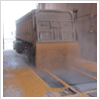
- Expert Forum Summary Report [PDF*]. OSHA, (2011, May 31), 58 pages.
These standards are NOT OSHA regulations. However, they do provide guidance from their originating organizations related to worker protection. In some cases, they may be mandated by State or local governments, or individual companies.
National Fire Prevention Association (NFPA)
NFPA develops, publishes, and disseminates more than 300 consensus codes and standards intended to minimize the occurrence and effects of fire and other risks. Virtually every building, process, service, design, and installation in society today is affected by NFPA documents. These standards may be viewed online at NFPA Codes and Standards. Those related directly to combustible dust explosion hazards are:
- 61, Standard for the Prevention of Fires and Dust Explosions in Agricultural and Food Processing Facilities
- 484, Standard for Combustible Metals
- 654, Standard for the Prevention of Fires and Dust Explosions from the Manufacturing, Processing, and Handling of Combustible Particulate Solids
- 655, Standard for Prevention of Sulfur Fires and Explosions
- 664, Standard for the Prevention of Fires and Explosions in Wood Processing and Woodworking Facilities
FM Global
These Standards address aspects of combustible dust hazards:
- Property Loss Prevention Data Sheet 7-73, Dust Collectors and Collection Systems
- Property Loss Prevention Data Sheet 7-76, Prevention and mitigation of Combustible Dust Explosion and Fire
International Code Council (ICC)
These Standards address aspects of combustible dust hazards:
- International Building Code
- International Fire Code
- International Mechanical Code
Consensus Standards and the General Duty Clause
The General Duty Clause, Section 5(a)(1) of the OSH Act, can be used to cite employers that fail to keep a workplace free of hazards, but only where there is no OSHA standard that applies to the particular hazard involved. In evaluating such situations, the hazard must be recognized (by industry or the employer), must have caused or be likely to cause death or serious physical harm, and a feasible means to correct the hazard must be available. Consensus standards  may be used to provide a feasible means of abatement and establish employer and industry knowledge.
Section 5(a)(1) is not:
- used to enforce "should" standards.
- used to require abatement methods not required by a specific standard.
- normally used to cover categories of hazards exempted by an OSHA standard.
Accessibility Assistance: Contact OSHA's Directorate of Standards and Guidance at (202) 693-1950 for assistance accessing DOC, MP4, PDF or PPT documents.
*These files are provided for downloading.

 Newsletter
Newsletter RSS Feeds
RSS Feeds Print This Page
Print This Page
 Text Size
Text Size








